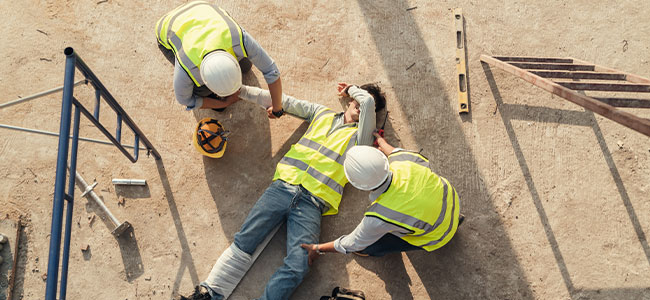
Falls are a Major Occupational Threat — How Do I Protect My People?
Occupational falls—often underestimated and primarily occurring at lower levels—have become the second-leading cause of worker deaths, necessitating a tailored and comprehensive approach to safety hazard mitigation across all industries.
- By Gen Handley
- Feb 26, 2024
A fall at work can be more dangerous than it seems. A major misconception of common slips, trips and falls is that they cause the most harm from tall heights and upper levels. The reality is that workers are more likely to die from the injuries experienced from falls at lower levels, which increased almost 3 percent according to the latest numbers on fatal occupational injuries. This data also found that fatalities from slips, trips and falls increased nearly 2 percent in 2022.
This makes occupational fall injuries the second-highest cause of worker deaths behind transportation incidents and a top safety priority for safety managers across all industries. The biggest challenge in addressing the broad category of slips, trips and falls is mitigating the varying possible causes for a worker to slip, trip, fall and hurt themselves. Because a deadly slip can occur almost anywhere, they need a customized, comprehensive approach to safety hazard mitigation, requiring various safety measures and protocols in completely different ways.
The Threat of Falls at Work
This danger of falls is present in a range of circumstances that can be found in almost any sector or job. The National Institute for Occupational Safety and Health says fall incidents at work can frequently involve circumstances including:
- Slippery, cluttered or unstable walking/working surfaces
- Unprotected edges
- Floor holes and wall openings
- Unsafely positioned ladders
- Misused fall protection
However, the potential risk for a fall hazard within the work environment can be more complicated than that, involving other factors such as cold weather and temperatures, additional PPE and equipment and improper footwear.
The Impact of Falls at Work
When an employee falls and hurts themselves at work, the consequences and required time off can broadly range from a sprained ankle to a major head injury. These injuries hurt not only the employees themselves, but their surrounding loved ones and coworkers, sometimes creating a lasting emotional impact on their lives.
It also impacts the company and its operations, requiring the time off needed to recuperate and remedy the problem so that it does not occur again and hurt more employees. According to the National Council on Compensation Insurance’s (NCCI) Workers Compensation Statistical Plan database, falls or slips were the third most costly lost-time workers’ compensation claims from 2020 to 2021, after motor vehicle crashes and burns.
What Employers Can Do
Thankfully, employers are not completely powerless to the many distinct, potential slips and falls hazards in their workplaces. The key is to remain organized and proactive, recognizing what these hazards are and staying ahead of them before they harm a person doing their job.
Regular Fall Hazard Assessments
In order to stay ahead of occupational fall hazards, it’s key to assess them on a regular basis, documenting all existing as well as future dangers that could harm employees down the road. Fall hazards and risks can easily shift with changes in staff or weather. So make sure assessments are conducted consistently or as needed.
Ongoing Safety Training
One of the most effective methods to proactively make sure people can perform their work around fall hazards safely is through safety training. Determine the type of training according to whichever fall hazards have been identified and require the financial and time commitment for this level of safety education.
Regular Clearing of Walkways
This may be an obvious point. However, the walkways in work environments must be always cleared of clutter and tripping hazards like electrical cords. What isn’t as obvious is committing to this practice and making it a habit within the workplace, incorporating it into daily tasks and routines.
Fall Protection Technology
In addition to safety practices, employees can be equipped with fall detection apps and wearables which can request immediate emergency help if the worker experiences an injury. In real time, fall protection devices will detect a dangerous impact and get help to the worker’s location as quickly as possible.
Provide proper footwear
Employees can also be provided with properly fitting footwear that can grip the surfaces they are working on more effectively and comfortably. In some cases, specific PPE footwear may be required, however, this can also be determined in the fall hazard assessment.
Develop Fall Protection Plan
Overarching all of this can be a fall protection plan, which outlines all of the procedures and policies that can help employees reduce the number of fall hazards in the workplace. OSHA has developed a template for a Fall Protection Plan that “must be developed and evaluated on a site-by-site basis.” Additionally, “it is recommended that builders discuss the written Fall Protection Plan with their OSHA Area Office prior to going on a jobsite.”
Be Prepared
No matter what, fall hazards are going to exist in the workplace and on worksites. However, employees can be prepared for the hazards and aware that they exist as well as what can be done now to prevent someone from spraining a limb at work or much worse.
This article originally appeared in the June 2024 issue of Occupational Health & Safety.